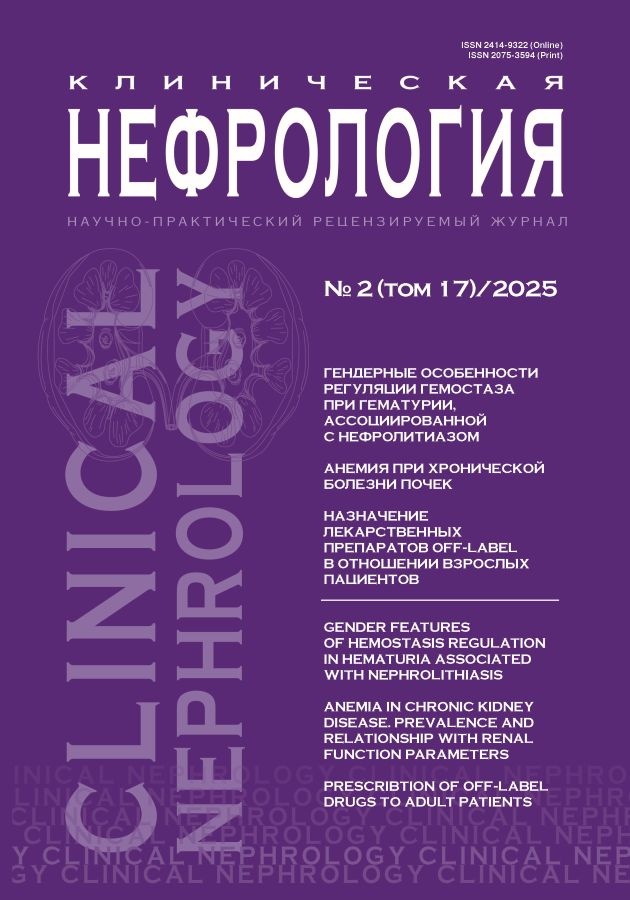Biomarkers of fibroplastic changes in the kidney in unilateral ureteral obstruction
- Авторлар: Shormanov I.S.1, Zhigalov S.A.1, Solovyev A.S.1, Bazhina O.V.1, Shormanova N.S.1
-
Мекемелер:
- Yaroslavl State Medical University
- Шығарылым: Том 17, № 2 (2025)
- Беттер: 37-41
- Бөлім: Nephrourology
- URL: https://journals.eco-vector.com/2075-3594/article/view/692666
- DOI: https://doi.org/10.18565/nephrology.2025.2.37-41
- ID: 692666
Дәйексөз келтіру
Аннотация
Objective. Evaluation of the dynamics of blood serum markers of fibroplastic transformation of the kidney in unilateral ureteral obstruction.
Material and methods. The study was approved by the local ethics committee of Yaroslavl State Medical University. A prospective comparative study was conducted, which included 33 patients with urolithiasis and unilateral ureteral obstruction caused by a stone less than 7 mm, and 15 healthy volunteers. The concentration of profibrotic cytokines TGF-β1 and CTGF was determined by ELISA. Diagnostics was performed using ultrasound and plain urography.
Results. In patients with ureteral obstruction, serum TGF-β1 (264±16.9 ng/ml) and CTGF (1141±33.1 ng/ml) concentrations at admission were significantly higher (p<0.001) than in the control group (TGF-β1 – 33±6.9 ng/ml, CTGF – 216.3±56.9 ng/ml). After 1 week, a sharp increase in TGF-β1 (18,239±556 ng/ml) and CTGF (45,765±123 ng/ml) levels was observed, indicating the development of severe fibrosis. After 1 month, blood cytokine concentrations decreased but remained above control values. Complete normalization of TGF-β1 (45±5.2 ng/ml) and CTGF (177±11.9 ng/ml) levels was observed only 2 months after obstruction elimination. In patients with prolonged obstruction (3–7 days), cytokine levels were significantly higher (p=0.03), indicating more pronounced fibrosis formation.
Conclusion. Unilateral ureteral obstruction leads to a significant increase in plasma TGF-β1 and CTGF levels, indicating the development of renal tissue fibrosis. The duration of obstruction affects the degree of fibrosis, emphasizing the need for early intervention and the promise of antifibrotic therapy.
Негізгі сөздер
Толық мәтін
Авторлар туралы
Igor Shormanov
Yaroslavl State Medical University
Хат алмасуға жауапты Автор.
Email: i-s-shormanov@yandex.ru
ORCID iD: 0000-0002-2062-0421
Dr.Med. (Med.), Professor, Head of the Urology and Nephrology Department
Ресей, YaroslavlSergey Zhigalov
Yaroslavl State Medical University
Email: sergey.zhigalow@gmail.com
ORCID iD: 0000-0003-2464-572X
Cand.Sci. (Med.), Associate Professor, Urology and Nephrology Department
Ресей, YaroslavlAndrey Solovyev
Yaroslavl State Medical University
Email: a-s-soloviev89@yandex.ru
ORCID iD: 0000-0001-5612-3227
Cand.Sci. (Med.), Associate Professor at the Urology and Nephrology Department
Ресей, YaroslavlOlga Bazhina
Yaroslavl State Medical University
Email: mascot212@mail.ru
ORCID iD: 0009-0004-5741-261X
Cand.Sci. (Med.), Associate Professor at the Urology with Nephrology Department
Ресей, YaroslavlNatalia Shormanova
Yaroslavl State Medical University
Email: lady.schormanova@yandex.ru
Cand.Sci. (Med.), Associate Professor at the Department of Pathological Anatomy
Ресей, YaroslavlӘдебиет тізімі
- Moe O.W. Kidney stones: pathophysiology and medical management. Lancet. 2006;367(9507):333–44. Doi: 10.1016/ S0140-6736(06)68071-9. [PMID: 16443041].
- Hubner W.A., Irby P., Stoller M.L. Natural history and current concepts for the treatment of small ureteral calculi. Eur. Urol. 1993;24:172.
- Sharma K., Ziyadeh F.N. The emerging role of transforming growth factor-beta in kidney diseases. Am. J. Physiol. 1994;266:829.
- Rupérez M., Ruiz-Ortega M., Esteban V. et al. Angiotensin II increases connective tissue growth factor in the kidney. Am. J. Pathol. 2003;163(5):1937–47. doi: 10.1016/S0002-9440(10)63552-3. [PMID: 14578193, PMCID: PMC1892441].
- Yokoi H., Sugawara A., Mukoyama M. et al. Role of connective tissue growth factor in profibrotic action of transforming growth factor-beta: a potential target for preventing renal fibrosis. Am. J. Kidney Dis. 2001;38(4 Suppl. 1):S134–8. doi: 10.1053/ajkd.2001.27422. [PMID: 11576939].
- Yokoi H., Mukoyama M., Sugawara A. et al. Role of connective tissue growth factor in fibronectin expression and tubulointerstitial fibrosis. Am. J. Physiol. Renal. Physiol. 2002;282(5):F933–42. doi: 10.1152/ajprenal.00122.2001. [PMID: 11934704].
- Martínez-Klimova E., Aparicio-Trejo O.E., Tapia E., Pedraza-Chaverri J. Unilateral Ureteral Obstruction as a Model to Investigate Fibrosis-Attenuating Treatments. Biomolecules. 2019;9(4):141. doi: 10.3390/biom9040141. [PMID: 30965656, PMCID: PMC6523883].
- Zhang C., Zhu Z., Liu J. et al. Expression of connective tissue growth factor in renal tubulointerstitial fibrosis in rats and its pathogenic role. J. Huazhong Univ. Sci. Technolog. Med. Sci. 2005;25(5):519–22. doi: 10.1007/BF02896005. [PMID: 16463662].
- Kinashi H., Falke L.L., Nguyen T.Q. et al. Connective tissue growth factor regulates fibrosis-associated renal lymphangiogenesis. Kidney Int. 2017;92(4):850–63. doi: 10.1016/j.kint.2017.03.029. [Epub 2017 May 23, PMID: 28545716].
- Ishidoya S., Morrisey J., McCracken R. et al. Angiotensin II receptor antagonist ameliorates renal tubulointerstitial fibrosis caused by unilateral ureteral obstruction. Kidney Int. 1995;47:1285
- Ito K., Chen J., El Chaar M. et al. Renal damage progresses despite improvement of renal function after relief of UUO in adult rats. AJP. Renal. Physiol 2004;287:1283.
- Kaneto H., Morrisey J., Klahr S. Increased expression of TGF-beta 1 mRNA in the obstructed kidney of rats with unilateral ureteral ligation. Kidney Int. 1993;44:313.
- Oka A., Toshino N., Miyauchi A., Yokoyama M. Expression of growth factors after release of ureteral obstruction in the rat kidney. Int. J. Urol. 1999;6:607.
- Martínez-Klimova E., Aparicio-Trejo O.E., Tapia E., Pedraza-Chaverri J. Unilateral Ureteral Obstruction as a Model to Investigate Fibrosis-Attenuating Treatments. Biomolecules. 2019;9(4):141. doi: 10.3390/biom9040141. [PMID: 30965656, PMCID: PMC6523883].
- Klahr S., Morrissey J. Obstructive nephropathy and renal fibrosis. Am. J. Physiol. Renal. Physiol. 2002;283(5):F861–75. doi: 10.1152/ajprenal.00362.2001. [PMID: 12372761].
Қосымша файлдар







